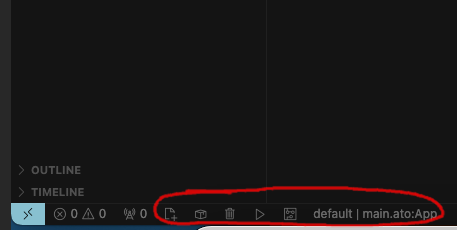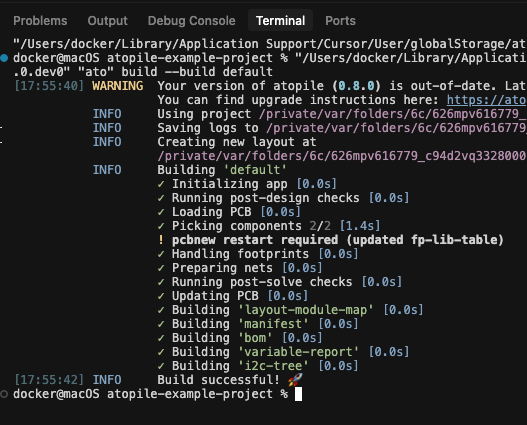Install via VSCode/Cursor (Recommended)
atopile officially supports VSCode and Cursor. We recommend using Cursor. AI is already getting very good at writingato code.
Download it here: https://www.cursor.com/
Once you have VSCode/Cursor just install the atopile VSCode/Cursor extension.
 After installation it will prompt you to install the
After installation it will prompt you to install the ato CLI. Click the Install Automatically button.

(Experimental) MCP server
(Experimental) MCP server
Set up an MCP server for this documentation with
Installing KiCAD
If you want to layout or route PCBs you will need to install KiCAD.Trying out an example
PressCtrl+Shift+P and search for atopile: Open Example.
 Choose any example you like from the selection.
After confirming wait for the
Choose any example you like from the selection.
After confirming wait for the ato menu bar to appear:
 Press on the play button to compile the example.
You will be greeted by the logs in the terminal:
Press on the play button to compile the example.
You will be greeted by the logs in the terminal:
 If you have KiCAD installed, you can now press on the PCB icon in the ato menu bar to open the layout file.
If you have KiCAD installed, you can now press on the PCB icon in the ato menu bar to open the layout file.
A typical workflow
- Sketch your circuit on paper.
- Search https://packages.atopile.io and GitHub for pre-existing modules you need, and use
ato addto install them. - Design a module and do its calculations using
atocode. - Run
ato buildto compile your project, choose components to suit your design, and update your layout (PCB) file. - Use KiCAD to lay out any changes
- Repeat steps 3-5 until you’re happy with your design.
- When you’re done with your design, push your changes to your repo.
- CI will automatically build and test your project, and generate the manufacturing files you need to order your PCBs.
- Take these manufacturing files to your PCB manufacturer to get your PCBAs.
Creating a project
Project Structure
Your new project will have a file structure like this:demo.ato- your atopile source file - this is where you write your atopile codedefault.kicad_pcb- the layout file - this is the “board” file that looks like a PCB, and you can order fromato.yaml- atopile’s configuration file - this file is how atopile knows this is a project and what to do when you runato build
Hello, World!
Here’s a simple example of atopile code: Updatedemo.ato (of whatever you’ve named your source file) with this code.
To build it, run:
--open flag does).
Your shiny ✨ new component should be waiting for you in the top left corner (possibly off the current screen).
 Oh yeah! We’re in business. 😎
Oh yeah! We’re in business. 😎
What’s next?
This isn’t even a circuit yet, merely a single component however you now:- Have the
atoCLI and compiler set up and working - Know how to add components to your design
- Have KiCAD installed and working

